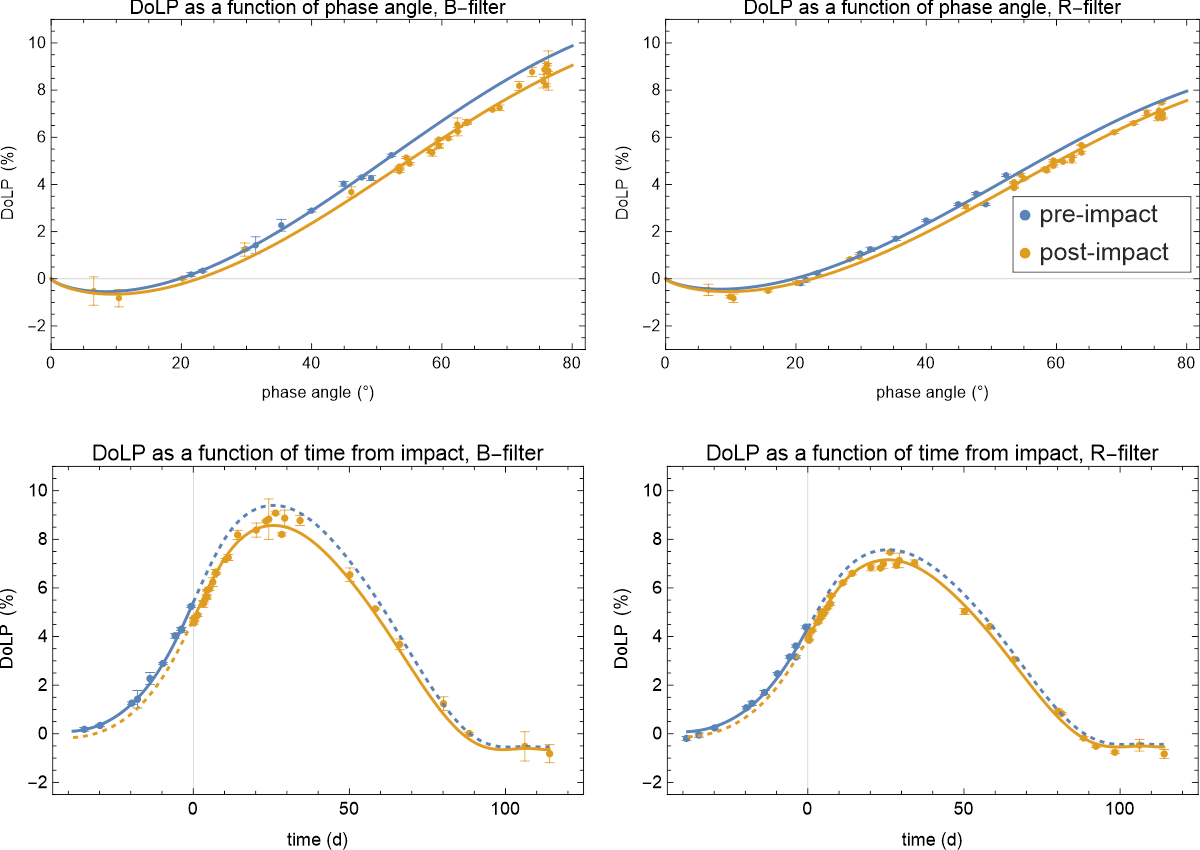- 1Department of Physics, University of Helsinki, Finland (antti.i.penttila@helsinki.fi)
- 2Asteroid Engineering Laboratory, Luleå University of Technology, Sweden
- 3Armagh Observatory & Planetarium, UK
- 4Mullard Space Science Laboratory, Department of Space and Climate Physics, University College London, UK
- 5Department of Astronomy, University of Maryland, USA
- 6Instituto de Astrofísica de Andalucá, CSIC, Spain
The NASA Double Asteroid Redirection Test (DART) impacted the smaller component, Dimorphos, of the Didymos binary system on 2022 September 26 (Daly et al. 2023). The planetary defense test successfully and clearly changed the orbit of Dimorphos around Didymos with a kinetic impact (Thomas et al. 2023). The impact caused dust and boulders to be ejected from the target, forming an ejecta cloud and tail for the system (Li et al. 2023). The system was extensively observed pre-impact and post-impact by both ground- and space-based observatories and the LICIACube spacecraft (see, e.g., de León et al. 2010; Opitom et al. 2023; Moskovitz et al. 2023; Dotto et al. 2023).
The polarimetric behavior and the degree of linear polarization (DoLP) of the system was observed with one of the units of ESO’s Very Large Telescope (VLT) in Chile (Bagnulo et al. 2023; Gray et al. 2024) and the Nordic Optical Telescope (NOT) in the Canary Islands, Spain (Gray et al. 2024). Polarimetry is independent of the absolute flux levels since it is a ratio of differences and sums of fluxes, making it a very efficient method to probe the properties of the surface regolith on the bodies and the dust in the ejecta tail.
We summarize the polarimetric data and present the statistical assessment of the polarimetric phase curve. From the modeling and extensive statistical tests it can be verified that the DoLP is in fact changed at the impact, and remains on a lower level at least several tens of days post-impact (see Fig. 1). We model the surface of the bodies and the dust around the system with random polyhedral Voronoi particles and their scattering response with geometric optics and radiative transfer. By fitting the differences between the two filters B and R we can assess the optical material properties of the dust, and by investigating the difference between pre- and post-impact system, we can derive physical changes in the dust governing the DoLP of the system. Our result is that the dominating post-impact particles are either smaller, or less space-weathered. These results can be re-assessed with the observations by the Hera mission and by ground-based observations before Hera’s arrival to Didymos system.

Figure 1: The DoLP observations of the Didymos system in B and R filters, and the fitted trigonometric DoLP phase curve model (Penttilä et al. 2005). The dependence is plotted as a function of phase angle (top row) and time (bottom row), expressed in days after the DART impact. The pre- and post-impact data have been fitted with separate models.
Daly, R., Ernst, C., Barnouin, O., et al. 2023, Natur, 616, 443
Thomas, C., Naidu, S., Scheirich, P., et al. 2023, Natur, 616, 448
Li, J.-Y., Hirabayashi, M., Farnham, T., et al. 2023, Natur, 616, 452
de León, J., Licandro, J., Serra-Ricart, M., Pinilla-Alonso, N., & Campins, H. 2010, A&A, 517, A23
Opitom, C., Murphy, B., Snodgrass, C., et al. 2023, A&A, 671, L11
Moskovitz, N., Thomas, C., Pravec, P., et al. 2023, PSJ, 5, 35
Dotto, E., Deshapriya, J., Gai, I., et al. 2023, Natur, 627, 505
Bagnulo, S., Gray, Z., Granvik, M., et al. 2023, ApJL, 945, L38
Gray, Z., Bagnulo, S., Granvik, M., et al. 2024, PSJ, 5, 18
Penttilä, A., Lumme, K., Hadamcik, E., & Levasseur-Regourd, A.-C. 2005, A&A, 432, 1081
How to cite: Penttilä, A., Muinonen, K., Granvik, M., Gray, Z., Bagnulo, S., Kolokolova, L., and Moreno, F.: Modeling linear polarization of the Didymos-Dimorphos system before and after the DART impact, Europlanet Science Congress 2024, Berlin, Germany, 8–13 Sep 2024, EPSC2024-301, https://doi.org/10.5194/epsc2024-301, 2024.